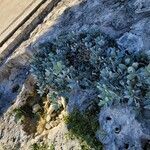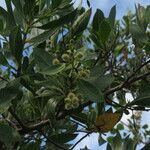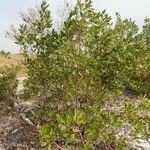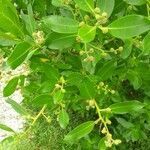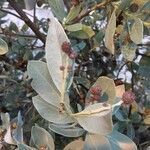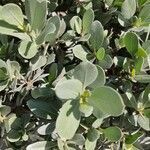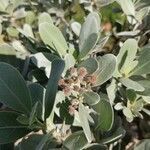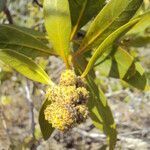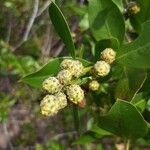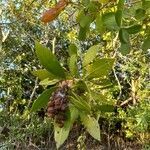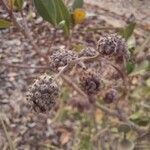Small tree up to about 8 m. high, sometimes sprawling or procumbent, with stilt-roots and flattened, slightly winged branchlets, usually appressed-pubescent at first, soon glabrescent. Leaves alternate, shortly petiolate or subsessile, petiole up to 4 mm. long, pubescent or glabrous with two prominent glands near the apex or at the base of the lamina, papyraceous, chartaceous or subcoriaceous, somewhat fleshy, lamina narrowly elliptic, up to 11 X 3.5 cm., often much smaller, usually glabrous, rarely very sparsely pubescent, acute and slightly acuminate at the apex, cuneate at the base and often decurrent into the petiole; midrib fairly prominent on the under surface, lateral nerves and reticulation rather inconspicuous. Flowers greenish-white, in the axils of small ovate or lanceolate ciliate bracts, aggregated in subglobose capitula, 3-5 mm. in diam., with sericeous peduncles 5-15 mm. long, forming a terminal panicle and capitula also sometimes solitary in the axils of the upper leaves. Lower receptacle (ovary) 1 mm. long, sericeous; upper receptacle (calyx) cupuliform, 1 X 1.5 mm., nearly glabrous, with lobes 0.5 mm. long. Stamens normally 10, biseriate, filaments 1.5-2 mm. long, anthers 0.5 mm. long. Disk pilose. Style 2 mm. long. Fruits squamiform, 3 X 3-3.5 mm., somewhat sericeous, recurved at the apex and often bearing the remains of the calyx, imbri-cated in a subglobose or cone-shaped structure, 1-1.5 X 0.7-1.3 cm.
A shrub or tree. It is often 1-4 m tall but can grow 20 m tall. The trunk can be 1 m across. The bark is thick and has broad plates. The leaves are simple and arranged alternately. The leaves are narrowly oval. They are 2-7 cm long by 1-3 cm wide. The flowers are small and green. The fruit are clusters of small winged seeds. They are like buttons. The seeds float.
